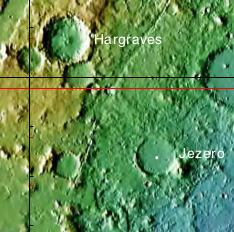Diameter 49.0 km (30.4 mi) | ||
 | ||
Eponym Jezero, Bosnia and Herzegovina | ||
Jezero is a crater on Mars located at 18.855°N 77.519°E / 18.855; 77.519 in the Syrtis Major quadrangle. The diameter of the crater is about 49.0 km (30.4 mi). Thought to have once been flooded with water, the crater contains a fan-delta deposit rich in clays.
The crater was named after one of the towns with this name in Bosnia and Herzegovina. In several Slavic languages, including Bosnian, Croatian, Czech, Serbian, Slovak and Slovene, the word jezero means "lake".
Mars 2020 mission
Jezero crater, once considered a site for the Mars Science Laboratory, is a proposed landing site for the Mars 2020 rover mission. After several Mars 2020 Landing Site Workshops, it survived the cut and was named to be among the top 3 sites still in the running for the landing. Life may have developed in the crater since it is believed the lake was long-lived; the delta may have required period of 106–107 years to form. Clay minerals have been detected in and around the crater. The Mars Reconnaissance Orbiter identified smectite clays. Clays form in the presence of water, so this area probably once held water and maybe life in ancient times. The surface in places are cracked into polygonal patterns. Such shapes often form when clay dries out. These patterns can be seen in the image below. The image shows a channel that carried water and sediments into Jezero crater.
Researchers described in a paper, released in March 2015, how an ancient Martian lake system existed in Jezero Crater. The study advanced the idea that water filled the crater at least two separate times. There are two channels on the northern and western sides of the crater that probably supplied it with water; both of these channels have delta-like deposit where sediment was carried by water and deposited in the lake. Craters of a given diameter are expected to have a certain depth; a depth less than expected means sediment has entered the crater. Calculations suggest that the crater may hold about one kilometer of sediments. Most of the sediments may have been brought in by channels. A primary aim of the Mars 2020 mission is to search for signs of ancient life. It is hoped that a later mission could then return samples from sites identified as probably containing remains of life. To safely bring the craft down, a 12-mile wide, smooth, flat circular area is needed. Geologists hope to examine places where water once ponded. They would like to examine sediment layers.
